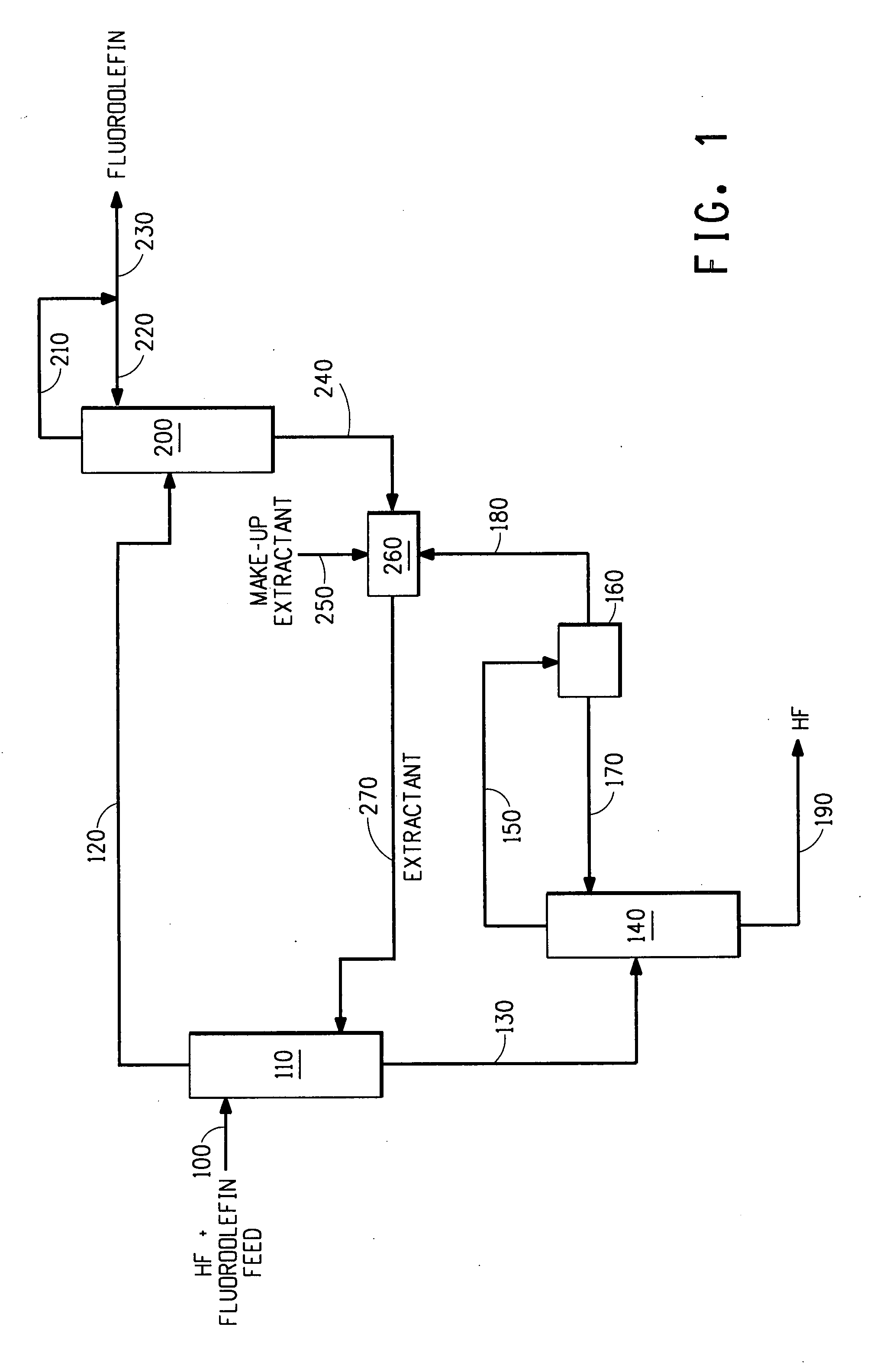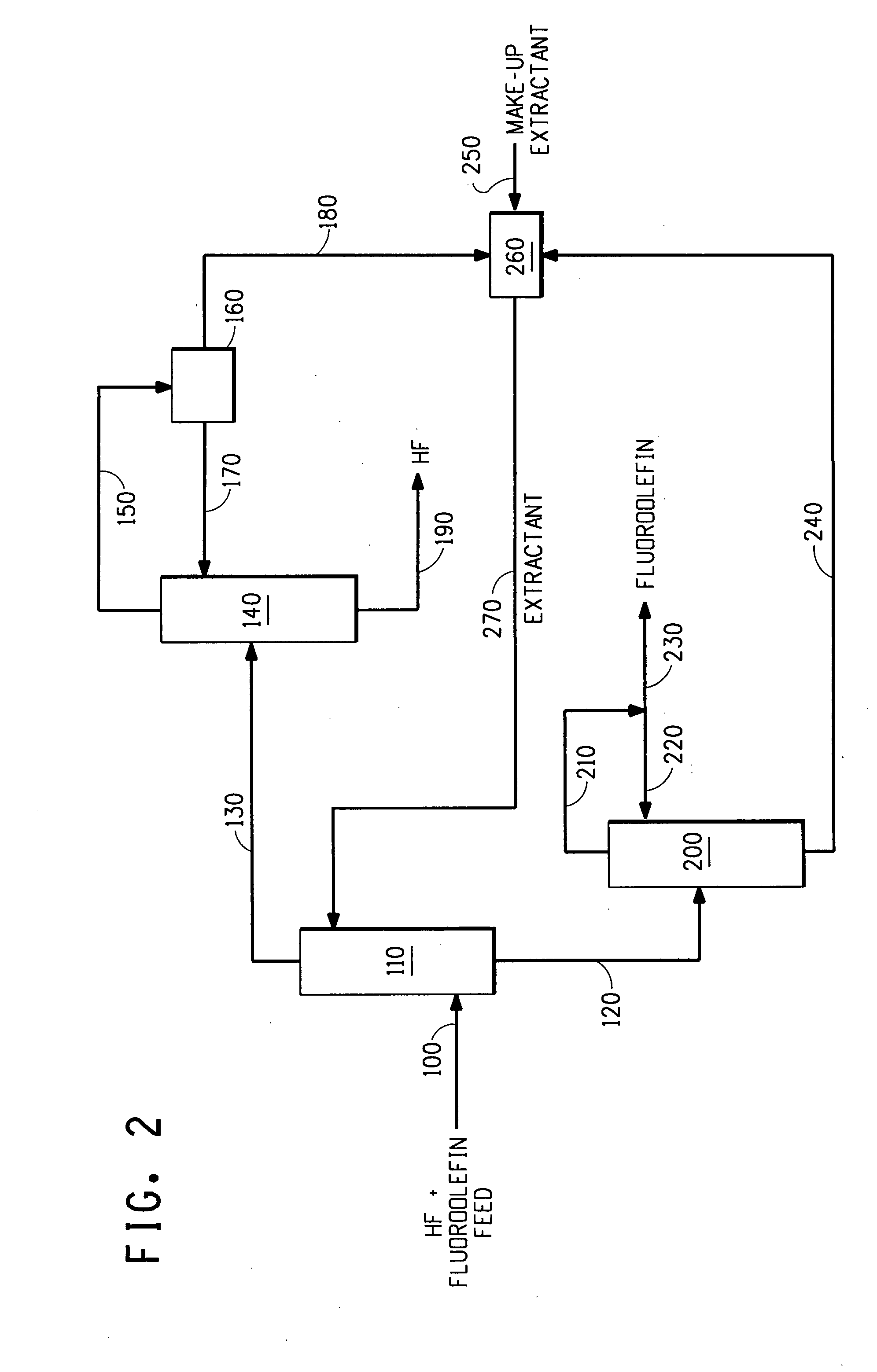Process for separating a fluoroolefin from HF by liquid-liquid extraction
a technology of fluoroolefin and liquid liquid, which is applied in the direction of separation process, halogenated hydrocarbon preparation, dissolving, etc., can solve the problems of large amount of scrubbing solution, ineffective separation of fluoroolefins from these mixtures, and ineffective distillation and decantation methods
- Summary
- Abstract
- Description
- Claims
- Application Information
AI Technical Summary
Benefits of technology
Problems solved by technology
Method used
Image
Examples
example 1
[0145]HFC-1225zc (1,1,1,3,3-pentafluoropropene) and HF form an azeotrope as disclosed in U.S. Patent Application Publication No. 2006 / 0116538 A1. Therefore, separation of HF from HFC-1225zc is not possible by conventional distillation. Example 1 demonstrates that HFC-1225zc may be separated from HF by liquid-liquid extraction using n-hexane as the extractant. A composition comprising 50 / 50 mole percent HF and HFC-1225zc is fed to the top of an extractor at 1000 lbs / hour (454 kg / hour). N-hexane (extractant) is fed to the bottom of the extractor at 500 lbs / hour (227 kg / hour). The data in Table 4 were calculated using measured thermodynamic properties.
TABLE 4HF / HFC-HFC-1225zcHFComponent or1225zc feedproductproductvariable(100)Extract (120)Raffinate (130)(230)(190)HF, wt %13.20.4498.00.69100HFC-1225zc,86.863.30.0399.31 ppmwt %n-hexane, wt %036.31.971 ppm6 ppmTemp, ° C.30.030.030.016.467.2Pres, psia (kPa)164.7 (1136)94.7 (653)94.7 (653)64.7 (446)65.7 (453.0)
The above data is calculated f...
example 2
[0146]Z-HFC-1225ye (Z-1,1,1,2,3-pentafluoropropene) and HF form an azeotrope as disclosed in U.S. Patent Application Publication No. 2007 / 0100174 A1. Therefore, separation of HF from Z-HFC-1225ye is not possible by conventional distillation. Example 2 demonstrates that Z-HFC-1225ye may be separated from HF by liquid-liquid extraction using 1,1,2-trichloro-1,2,2-trifluoroethane (CFC-113) as the extractant. A composition comprising 50 / 50 mole percent HF and Z-HFC-1225ye is fed to the bottom of an extractor at a rate of 1000 lbs / hour (454 kg / hour). CFC-113 (extractant) is fed to the bottom of the extractor at a rate of 800 lbs / hour (363 kg / hour). The data in Table 5 were calculated using measured thermodynamic properties.
TABLE 5Z-HFC-HF / Z-HFC-1225yeHFComponent or1225ye feedExtractRaffinateproductproductvariable(100)(120)(130)(230)(190)HF, wt %13.20.792.11.3100Z-HFC-1225ye,86.852.0200 ppm98.7wt %CFC-113, wt %047.37.910 ppm 5 ppmTemp, ° C.30.025.025.025.267.2Pres, psia (kPa)164.7 (1135....
example 3
[0147]HFP (hexafluoropropene or PFC-1216) and HF form an azeotrope as disclosed in U.S. Pat. No. 6,407,297. Therefore, separation of HF from HFP is not possible by conventional distillation. Example 3 demonstrates that HFP may be separated from HF by liquid-liquid extraction using tetrachloroethylene (perchloroethylene or PCE) as the extractant. A composition comprising 50 / 50 mole percent HF and HFP is fed to the bottom of an extractor at a rate of 1000 lbs / hour (454 kg / hour). PCE (extractant) is fed to the top of the extractor at a rate of 800 lbs / hour (363 kg / hour). The data in Table 6 were calculated using measured thermodynamic properties.
TABLE 6HFComponent orHF / HFP feedExtractRaffinateHFP productproductvariable(100)(120)(130)(230)(190)HF, wt %11.80.3597.30.66100HFP, wt %88.252.31.699.34PCE, wt %047.31.110 ppmTemp, ° C.30.030.030.0−11.095.4Pres, psia (kPa)164.7 (1135.6)144.7 (998)144.7 (998)34.7 (239)135.7 (936)
The above data is calculated for an extractor with 6 theoretical sta...
PUM
| Property | Measurement | Unit |
|---|---|---|
| temperature | aaaaa | aaaaa |
| temperature | aaaaa | aaaaa |
| temperature | aaaaa | aaaaa |
Abstract
Description
Claims
Application Information
 Login to View More
Login to View More - R&D
- Intellectual Property
- Life Sciences
- Materials
- Tech Scout
- Unparalleled Data Quality
- Higher Quality Content
- 60% Fewer Hallucinations
Browse by: Latest US Patents, China's latest patents, Technical Efficacy Thesaurus, Application Domain, Technology Topic, Popular Technical Reports.
© 2025 PatSnap. All rights reserved.Legal|Privacy policy|Modern Slavery Act Transparency Statement|Sitemap|About US| Contact US: help@patsnap.com


